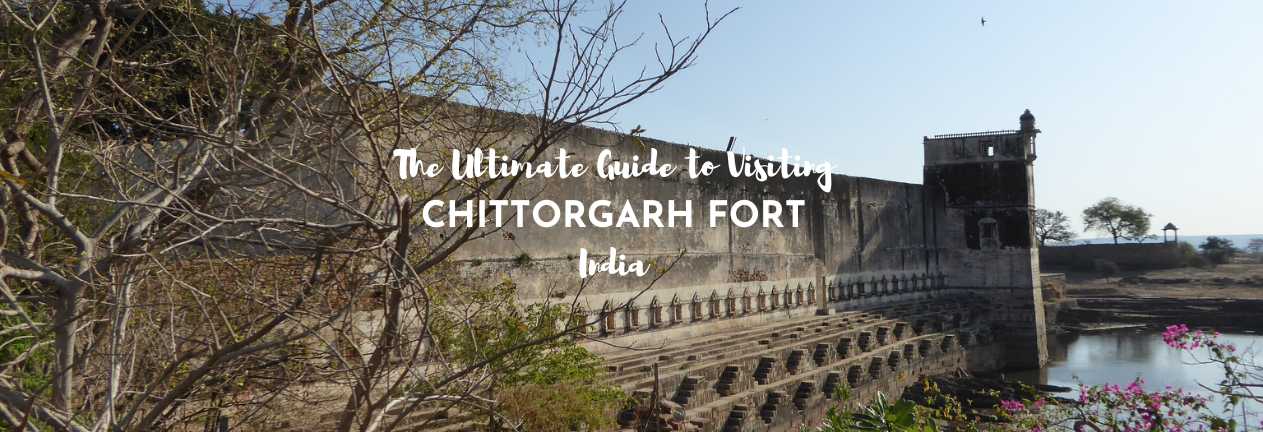Chittorgarh Fort is the largest fort of the UNESCO World Heritage Listed Rajasthan Hill Forts. It was built in the 7th century and is the stuff of legend. The fort and city below are also known as both Chittogarh and Chittaurgarh. The fort is mentioned in the Indian epic, the Mahabharata and is referenced in numerous Indian legends. The founder of the city of Udaipur, Maharana Udai Singh was also born here. Chittorgarh has a dark history too – when the fort was sacked (three times in the 15th and 16th century), 13,000 women and children of the fort committed mass Jauhar (suicide).
THIS POST MAY CONTAIN COMPENSATED AND AFFILIATE LINKS MORE INFORMATION IN OUR DISCLAIMER
The fort and city are located in the southern part of the state of Rajasthan. It’s mid way between Delhi and Mumbai.
EASIEST WAY TO VISIT
Chittorgarh Fort Day Trip from Udaipur
The easiest way to visit Chittorgarh Fort is on a day trip from Udaipur. Get A/C transport, a guide and easy access to the fort.
The Best Way to visit Chittorgarh Fort
Chittorgarh is only about 120 kilometres from Udaipur, and most people visit Chittorgarh Fort from Udaipur as it’s an easy day trip from there. Sadly we were approaching from Jaipur, which is 300 kilometres distant. Our schedule now was driven by needing to find somewhere to both celebrate the Indian festival of Holi and hunker down somewhere during it. And, of course, fitting in seeing the forts of Chittorgarh and Kumbhalgarh. There’s a railway station with good links at Chittorgarh and there are regular buses to the city too. However for our schedule we needed to arrive in the early morning and get out by lunchtime. That meant we needed to take an overnight bus from Jaipur, see the fort, and then move on from there. The bus stop is very close to the main hotel area (around 100 metres), although the fort is 2 kilometres up a hill from it.
Key Information and Details on Visiting Chittorgarh Fort
As one of the Rajasthan hill forts, the construction of Chittorgarh fort is impressive, but it’s not the easiest of sites to visit. Getting there is a challenge, the easiest way to visit Chittorgarh is on a day trip from Udaipur
Is it Chittorgarh Fort or Chittaurgarh Fort?
It’s both. You’ll find Chittorgarh spelled both ways.
How much time is required to visit Chittorgarh Fort?
You’ll want to spend around 4 hours visiting the Fort at Chittorgarh. This will give you plenty of time to explore the various palaces and structures within. There’s very little shade here at Chittorgarh, so you’ll want to start early and take a break during the hot part of the day.
If you’re traveling independently you will still need transport at the fort, as you cannot walk around the fort easily, it’s just too big. You can hire a rickshaw locally, but taking a guide is the best option. You can take a guide directly from Chittorgarh, or have the option of a guide and transfer from Udaipur.
What’s the best time to visit Chittorgarh Fort?
It’s best to visit Chittorgarh Fort between October and April. You’ll get the best weather during this time. Additionally, try and visit in the morning to escape the heat of the day.
How to take a tour of Chittorgarh Fort?
You can take a tour of Chittorgarh Fort from Udaipur – there are options here. Alternatively, if you wish to stay overnight, then you can hire a guide and transport for a tour of the fort from Chittorgarh here.
Where to stay to visit Chittorgarh Fort
If you wish to stay locally to visit Chittorgarh there are limited options and you’ll want to book early. Most people will stay in Udaipur and take a day trip to visit Chittorgarh Fort. The best-rated place that we found to stay in Chittorgarh is the Hotel Grand.
What’s the Chittorgarh Fort Ticket Price?
Citizens of India and SAARC (Bangladesh, Nepal, Bhutan, Sri Lanka, Pakistan, Maldives, and Afghanistan) and BIMSTEC Countries (Bangladesh, Nepal, Bhutan, Sri Lanka, Thailand, and Myanmar) are charged 40 INR per entry. All other foreign visitors pay 600 INR per head.
Is Chittorgarh Fort Worth Visiting?
Yes. It is a unique part of the heritage of this region and it’s very different from the other Indian Hill Forts that you’ll see.
Which is better? Chittorgarh Fort or Kumbhalgarh Fort?
They’re really, really different, and can’t be compared. The location in which you’ll find them and also the interiors are distinctly different. I would definitely visit both. You can read about our visit to Kumbhalgarh fort here.
How to Get to Chittorgarh Fort
Chittorgarh is 200 kilometers (125 miles) from Udaipur, which is the closest city to the fort. Most visitors come to Chittorgarh on a day trip from Udaipur.
If you’re traveling independently, then you can take the train to Chittorgarh Junction, or a bus. The railway station at Chittorgarh is about 6 kilometers (3.7 miles) from the fort. You can find a rickshaw at the train station to take you to the fort and the city.
How we visited Chittorgarh Fort
We dropped our bags at the Hotel Heritage, where we negotiated the use of a room for a few hours, in order that we could have a shower when we were finished. We then took an auto rickshaw from the hotel for three hours to visit the fort. Our driver took us up to the fort, around the various areas we wanted to see and then returned us to the town afterwards. We set off on our tour at 07:30, after we’d breakfasted. The fort is large, but the distance is potentially walkable, if you have the time and the inclination, but we had neither.
What to see at Chittorgarh Fort
From the very beginning, Chittorgarh is stunning, and going through the entrances is quite spectacular.
Entrances to Chittorgarh Fort
The entrance to the fort is up a winding well kept road, our auto rickshaw zooms up in usual fashion. We pass through the first gate, the Ram Pol, this is one of seven gates that that we must pass through in order to enter the fort. The gates are Padan Pol, Bhairon Pol, Hanuman Pol, Ganesh Pol, Jodla Pol, Laxman Pol and this first main entry gate, Ram Pol.
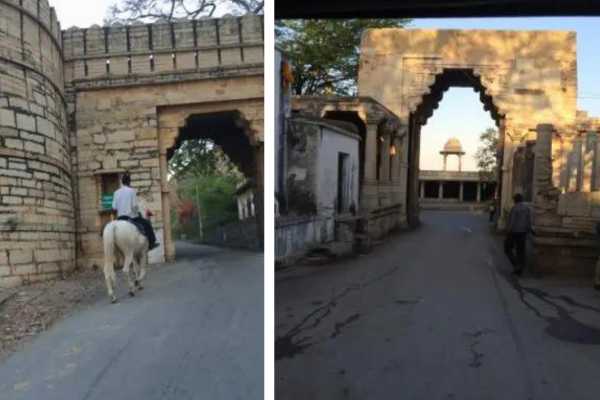
The gateways are all massive, with defences against elephants and cannon. There are also fortified parapets for archers to sit and wait in.
The Chittorgarh Fort ticket price is 40 INR for Indians and 600 INR for foreign visitors. (source ASI India)
Layout of Chittorgarh Fort
Once we get to the top, there’s a circular road that links and provides access to all the monuments, temples and palaces in the fort. As Chittorgarh was always under threat of siege it needed a strong water supply and originally had 84 water tanks, thus it was known as the Water Fort. These tanks could hold four billion litres, which could sustain an army of 50,000 for four years.
The fort has a circumference of 13 kilometres and covers 700 acres. There are four palaces, two towers, 19 primary temples and many more historic structures within the confines of the fort.
We confine ourselves to the major monuments and palaces, and of course the whims of our auto driver, who’s taken it upon himself to take us where he wants us to go.
We start our visit at the Samadhisvara Temple.
Exploring the Samadhisvara Temple, Chittorgarh Fort
Built in the 11th century this temple is covered in elaborate carvings – we descend the nearby staircase to the Gaumukha Kund.
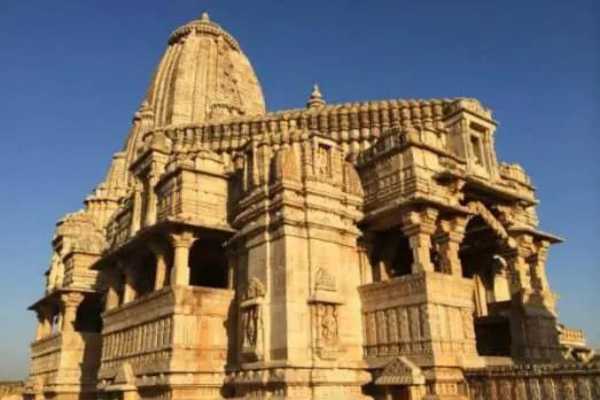
Gaumukha Kund, Chittorgarh Fort
The most picturesque of the water tanks is the Gaumukha Kund. It’s a deep tank filled by a spring coming from what’s described as a ‘cow mouth’, situated at the edge of the cliff, near the Samadhisvara Temple. Our photos do not do it justice and we’re too lazy and tired to go and get a better shot!
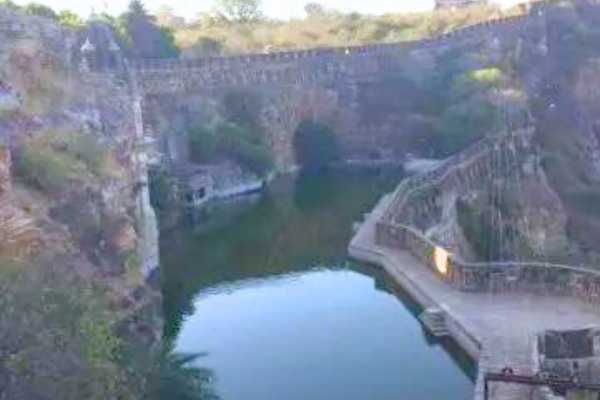
Vijay Stambha, Chittorgarh Fort
The Victory Tower is known as the symbol of Chittorgarh. It was erected by Rana Khumbha between 1458 and 1468 to commemorate his 1440 victory over the Sultan of Malwa.
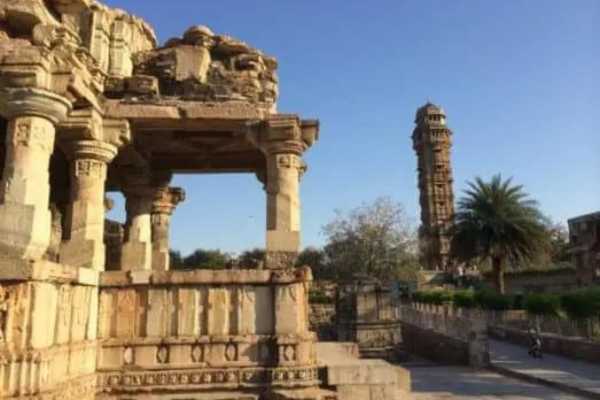
It is 37 metres and nine stories tall. The narrow internal circular staircase rises over 157 steps to the eighth floor. On each floor there are balconies and superb views of the city.
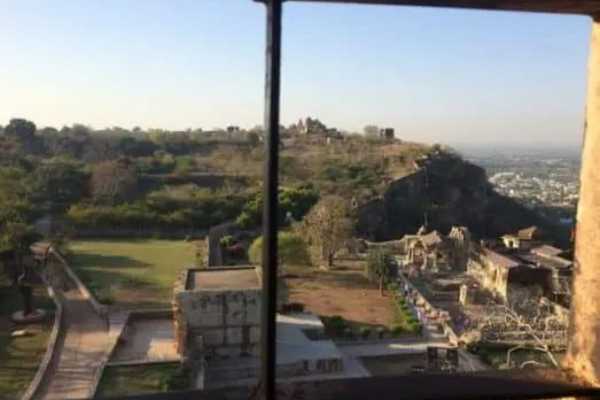
There are carvings on the inside and outside of the tower. The dome was added later and has been damaged by lightning and repaired.
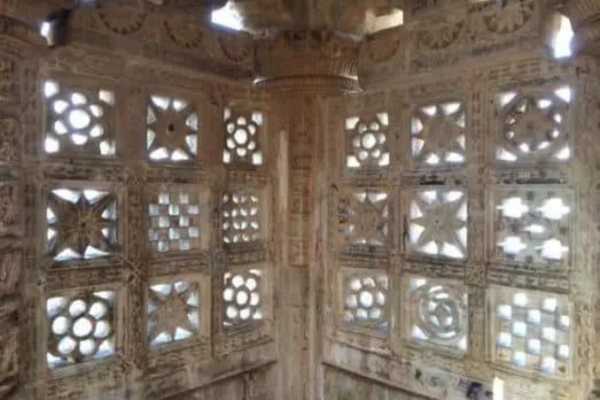
Padmini Palace, Chittorgarh Fort
Padmini’s Palace (Queen’s Palace): This palace is of incredible historical importance in Mewar. Named after Rani Padmini the palace stands within the Padmini lake. It was here that Rana Ratan Singh showed a glimpse of his wife, the Rani Padmini to Ala-ud-Din Khalji through a mirror. Reacting to the legendary beauty, Ala-ud-Din Khalji then sacked the city of Chittorgarh in order to possess Padmini.
During the fighting the Maharana, Ratan Singh was killed. Padmini committed Jauhar (suicide). The building is white and has three stories, although this is a 19th century reconstruction of the original. In the centre of the lake is the Jal Mahal (a palace surrounded by water).
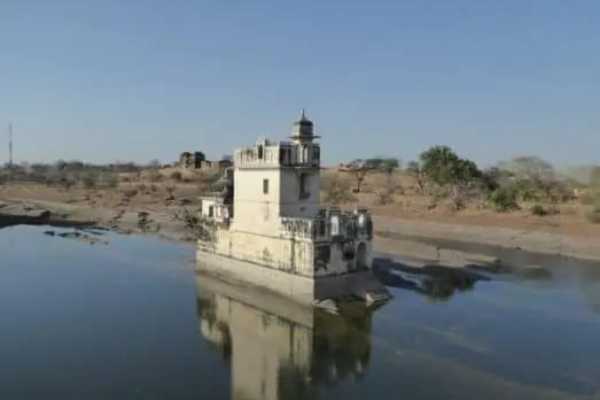
Kirti Stambha, Chittorgarh Fort
The Kirti Stambha, or Tower of Fame is 22 metres high. The outside is covered in Jain sculptures. It was probably built in the 12th century and its building is attributed to a Jain merchant, Jijai Rathod. It is dedicated to the first Jain teacher.
There are six levels and 54 steps to the top on a very narrow stairway. The top pavilion was added in the 12th century.
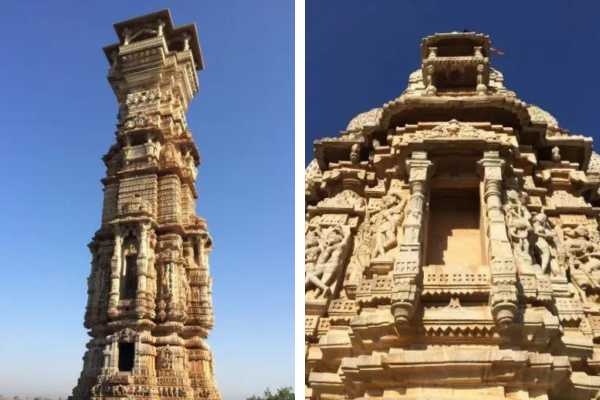
The tower is dedicated to Vishnu and is built of red sandstone and white marble. We take a look also at the gate on the far side of the fort, which looks into the open countryside.
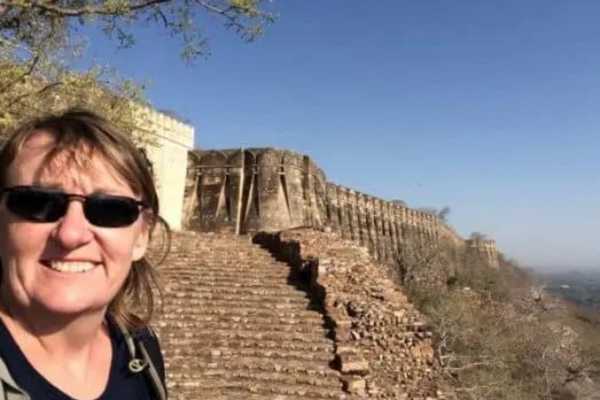
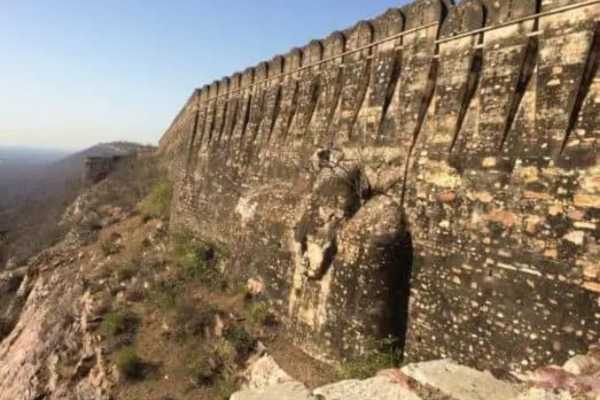
Rana Kumbha’s Palace:
We finish our visit to Chittorgarh Fort at the Rana Kumbha Palace. This is the oldest building within the fort. There are glimpses of past glories, as this is where Maharana Udai Singh, the founder of Udaipur, was born. It’s also here that Rani Padmini threw herself onto the funeral pyre, in her act of Jauhar.
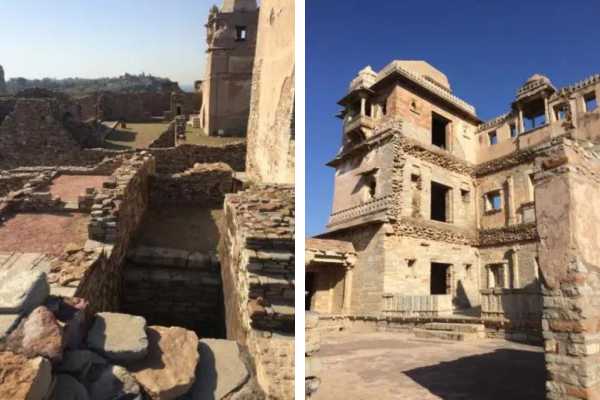
There are a host of other temples throughout the Fort, but our time is limited, so we head back down to the town, where we’ll have an early lunch, a shower and to catch our next ride. We’ve booked a car and driver to take us to Kumbhalgarh Fort where we’ll spend several hours before then being driven to Udaipur.
UNESCO Sites to Visit in India
If you like visiting UNESCO World Heritage Sites, then you’ll love our guides to India’s best World Heritage sites
- Champaner Pavagadh, in Gujarat
- The Taj Mahal in Agra
- The Ajanta Caves
- Ellora Caves
- Khajuraho’s Temples
- Humayun’s Tomb, Delhi
- Sanchi
- The Hill Forts of Rajasthan
- The Darjeeling Hill Railway
- Qutub Minar in Delhi
- The Mahabodhi Temple in Bodhgaya
- Mahabalipuram
Travel Tips for Exploring India
- Get Travel Insurance: Civitatis includes medical expenses, repatriation, theft, luggage delays. No deductibles or upfront payments. Get a quote here.
- Get online immediately with an eSIM for India
- Protect your data – use a VPN in India – use this coupon to get 3 months free.
- Book the best tours and guides in India on GetYourGuide or Klook
- Find the right accommodation for you via Booking.com
- Book Trains and Buses in India with 12goAsia
Final Words on Visiting Chittorgarh Fort
It took a heck of a lot of effort to get here to Chittorgarh Fort, but we’re glad we came. Our day trip to Chittorgarh got us to another of the glorious Indian forts. There’s a whole lot of history here, most of which we didn’t know before we arrived. It’s an immense fort, and well worth the effort to explore.
ASocialNomad is a participant in the Amazon Services LLC Associates Program, an affiliate advertising program designed to provide a means for sites to earn advertising fees by advertising and linking to amazon.com, amazon.co.uk, and amazon.ca. Amazon and the Amazon logo are trademarks of Amazon.com, Inc. or its affiliates. As an Amazon Associate, I earn from qualifying purchases.
